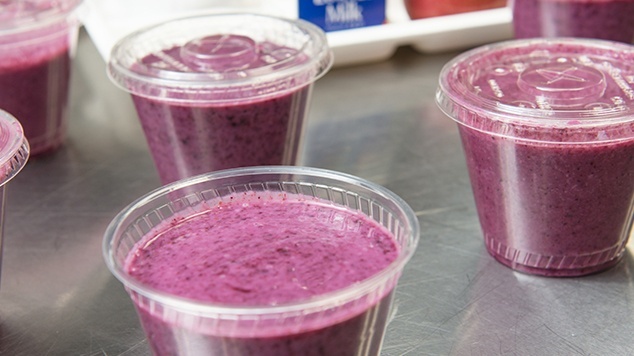Breakfast Participation Surges FROM 4% TO 24% With Wild Blueberry Smoothies
All chefs must contend with finicky customers. But Blair Currier, director of the Yarmouth School Nutrition Program in Maine, arguably has some of the most discriminating appetites to sate: the K-to-12 set.
“The most challenging thing is keeping kids engaged and interested in foods,” said Currier, who earned his credentials as a School Nutrition Specialist. “They go so quickly to processed food.”The Wild Blueberry has become a go-to ingredient for Currier.
He has developed a Wild Blueberry Sauce and a Wild Blueberry Smoothie, made with frozen Wild Blueberries, vanilla yogurt, and orange juice. He has even created a Wild Blueberry Kelp Smoothie that the kids love.

“Wild Blueberries are a no brainer,” he said. “In comparison to other berries and fruits, Wild Blueberries have a flavor kids really love.” What’s more, the rich color and flavor it adds when combined with other ingredients for a smoothie can’t be beat.
And that’s important.
Currier isn’t just trying to win a popularity contest. Pleased palates translate to financial sustainability. The more kids buy meals and snacks from school, the more economies of scale can be achieved, and the lower the cost of food service. That’s important, as the state caps school meal prices at $2 for breakfast and $3 for lunch.
“I have to make sure that any ingredient I use or anything I invest in has the greatest amount of impact,” Currier said.
Above all, frozen Wild Blueberries are practical: they’re easy and efficient to prepare and serve in big batches.
“Individually quick frozen (IQF) Wild Blueberries are extremely easy to use and convenient,” Currier added. With smoothies, for instance, the frozen Wild Blueberries keep the other ingredients chilled, which means that we don’t have to use additional ice, which would dilute the taste and the component credits. “A little bit of Wild Blueberry goes a long way, especially when it comes to giving a smoothie a vibrant color,” he said.
[blog_cta post_id=”16166″]
Sales and food cost are important numbers in this small district with 1,600 students enrolled with a 10 percent Free/Reduced rate. Yarmouth added muffins and Wild Blueberry smoothies to the menu and the average daily student participation in breakfast shot up from 4 percent to 24 percent!
This helped counter new restrictions on the kinds of snacks Currier can sell, and it created new energy in the cafeteria for students excited with the changes. The Wild Blueberries are available through the USDA Commodity Foods program and help keep food cost low with over $37,000 worth of foods purchased annually.
And Currier has continued to tinker with new Wild Blueberry recipes.
In 2016, working with Ocean Approved, a local seaweed processing company, he introduced a non-dairy version of the Wild Blueberry smoothie made with kelp cubes. The kelp didn’t affect the taste, but provided iodine vital to healthy thyroid function as well as body to the smoothie. By using bananas as its base, it had a lower sugar content than the version of the smoothie made with vanilla yogurt.
The Wild Blueberry Kelp Smoothie was part of the winning menu that made Currier and Nikki Davoren, his Yarmouth Middle School Assistant Manager, champions of the 2017 Farm-to-School Cook-off in April, created by the Maine Department of Education to showcase skills of local school food service staff and promote locally-grown products served in schools.

The Wild Blueberry Kelp Smoothie “was a creative way of introducing a less common but nutrient-dense ingredient into a meal,” said Stephanie Stambach, Child Nutrition Consultant for the Maine Department of Education.
For the competition, each team had to prepare a breakfast and lunch within a specific time frame using at least two ingredients that are grown, raised, caught, or manufactured in Maine and meet National School Breakfast and Lunch Program requirements as well as one USDA food. Maine Wild Blueberries and Maine potatoes were used as “challenge” ingredients in the competition. All recipes will be shared in an upcoming Farm-to-School Cook-off recipe book.


